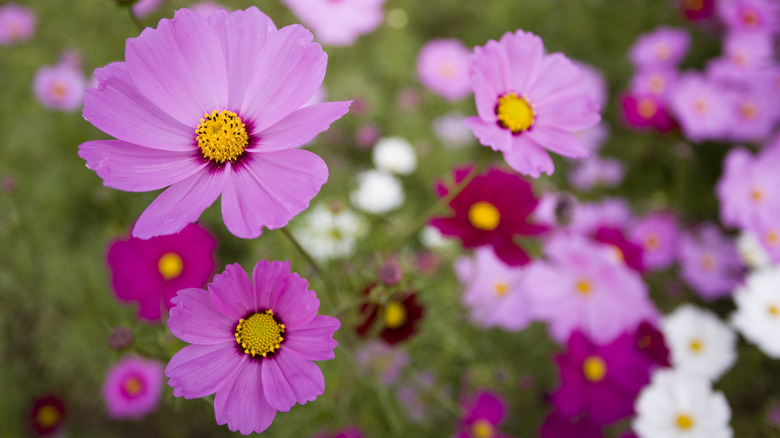Fall time for most gardeners is a season of harvest and readying the plots for the next year’s crop. Aside from the rogue bulb of garlic or seeds of asparagus, most plants are sown in the spring and harvested either shortly after or during a later season. That being said, cosmos are delicate, whimsical flowers that bloom in early- to mid-summer, but are among a cohort of plants that are just getting started in the fall.
Known for their bright, colorful petals around a yellow center, these easy-to-grow flowers resemble daisies. They are available in a variety of shades, including pink, purple, white, and orange. The petals are delicate and feathery and can grow up to 1-7 feet tall, depending on the variety, and they have fern-like foliage that adds to their overall beauty.
To sow cosmos seeds, start by preparing the soil in a sunny spot in your garden after a few hard fall frosts, with temperatures falling below 28°F. Loosen the soil and remove any weeds or debris. Scatter the cosmos seeds evenly over the soil and lightly press them into the ground. Water the area gently to ensure good seed-to-soil contact. Sowing cosmos seeds in the fall allows them to undergo a period of cold stratification, which helps to break their dormancy and promotes better germination in the spring. This method also gives the plants a head start, allowing them to establish strong root systems before the growing season begins.
How to care for cosmos in your garden

Once your cosmos have sprouted up in the spring, they are relatively easy to nurture and can add a pop of color to your blooming garden. To care for cosmos flowers, there are a few best practices to keep in mind. They prefer well-drained soil and full sun, so choose a sunny spot in your garden for planting. Cosmos are drought-tolerant plants, but they still need regular watering, especially during dry spells. Water them deeply once a week, making sure the soil is moist but not waterlogged. Avoid overhead watering as it can lead to fungal diseases.
Cosmos are not heavy feeders and do not really require any additional fertilization. Adding fertilizer to your garden with cosmos can actually have an adverse effect, encouraging tall, leggy growth which isn’t as aesthetically pleasing. However, to encourage continuous blooming, deadhead the spent flowers regularly. This will prevent the plant from going to seed and redirect its energy towards producing more flowers.
Some taller varieties of cosmos, like their sunflower cousins, may require staking to prevent them from flopping over. Use bamboo stakes or other supports to keep the plants upright. Additionally, applying a layer of organic mulch around the base of the plants can help conserve moisture, suppress weeds, and regulate soil temperature. Finally, cosmos are generally resistant to pests and diseases. However, keep an eye out for aphids, slugs, and snails. If necessary, use organic pest control methods to manage infestations.
Other important details to consider

Planting cosmos in the fall works well in growing zones that experience hard frosts, as the colder temperatures will prevent the cosmos from trying to grow throughout the winter. When the seedlings pop up in the spring, it’s important to keep them covered through the last frost to protect their delicate stems and ensure they have a healthy growing season. Planting cosmos in the fall does require some careful math to happen after a fall frost but before the ground is too frozen to dig in, so keep an eye on your future flower bed. In hotter USDA zones that do not experience frosts, such as zones 9A or higher, cosmos will behave as hardy perennials and can last throughout the winter season.
Another important detail to keep in mind, especially for beginners who have not planted cosmos before, is that they are self-seeding plants. Self-seeding plants will drop seeds in your garden so that they can return the following year. Since cosmos are great self-seeders, they can take over your garden. If you want to have more control over your collection of cosmos in your flower bed, it’s recommended that you deadhead, or cut off, the flower heads before they go to seed. This process should be done once the blooms start to fade. The best part about deadheading cosmos is that it will actually encourage the plant to bloom again if it’s early enough in the season.




